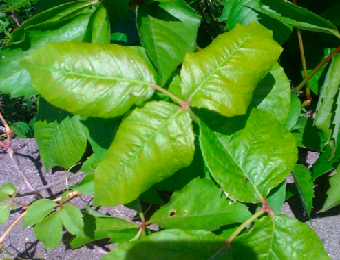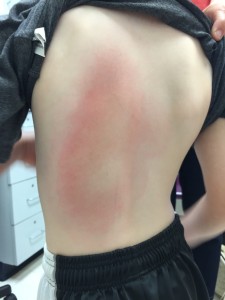Ouch! Those nasty wasp and bee stings
Ouch! Stung on the scalp.
Ouch! Stung on the hand.
Ouch! Stung on the leg.
Ouch! Ouch! Stung TWICE on the lips.
Those nasty, nasty hornets. During the hot days of August, they become more and more territorial and attack anything near their nests. Today, in my yard, hornets mercilessly chased and attacked a fourth grader named Dan. As everyone knows, you’d rather have something happen to yourself than have something negative happen to a child who is under “your watch.” As I rolled out the Slip and Slide, I was relieved not to see any wasps hovering above nests buried in the lawn. I was also falsely reassured by the fact that our lawn had been recently mowed. I reasoned that anything lurking would have already attacked a lawn mower. Unfortunately, I failed to see the basketball sized grey wasp nest dangling insidiously above our heads in a tree. So, when a wayward ball shook the tree, the hornets found Dan.
What will you do in the same situation?
Assess the airway- signs of impending airway compromise include hoarseness, wheezing (whistle like sounds on inhalation or expiration), difficulty swallowing, and inability to talk. Ask if the child feels swelling, itchiness or burning (like hot peppers) in his or her mouth/throat. Watch for labored breathing. If you see the child’s ribs jut out with each breath, the child is struggling to pull air into his/her body. If you have Epinephrine (Epi-Pen or Twin Jet) inject immediately- if you have to, you can inject through clothing. Call 911 immediately.
Calm the panic- being chased by a hornet is frightening and the child is more agitated over the disruption to his/her sense of security than over the pain of the sting. Use pain control /self calming techniques such as having the child breath slowly in through the nose and out through the mouth. Distract the child by having them “squeeze out” the pain out by squeezing your hand.
If the child was stung by a honey bee, if seen, scrape the stinger out with your fingernail or a credit card. Do not squeeze or pull with tweezers to avoid injecting any remaining venom into the site. Hornets, and other kinds of wasps, do not leave their stingers behind. Hence the reason they can sting multiple times.
Relieve pain by administering Ibuprofen (Motrin,Advil) or Acetaminophen (Tylenol).
As you would with any break in the skin, to prevent infection, wash the affected areas with mild soap and water.
Decrease the swelling. Histamine produces redness, swelling and itch. Counter any histamine release with an antihistamine such as Diphenhydramine (Benadryl). Any antihistamine will be helpful, but generally the older ones like Diphenhydramine, tend to work the best in these instances. Unfortunately, sleepiness is common side effect.
To decrease overall swelling elevate the affected area.
A topical steroid like hydrocortisone 1% will also help the itch and counter some of the swelling.
And don’t forget, ice, ice and more ice. Fifteen minutes of indirect ice on and fifteen minutes off.
Even if the child’s airway is okay, if the child is particularly swollen, or has numerous bites, a pediatrician may elect to add oral steroids to the child’s treatment.
It is almost midnight as I write this blog post. Now that I know all of my kids are safely tucked in their beds, and I know that Dan is fine, I turn my mind to one final matter: Hornets beware – I know that at night you return to your nest. My husband is going outside now with a can of insecticide. Never, never mess with the mother bear…at least on my watch.
Naline Lai, MD and Julie Kardos, MD
©2009 Two Peds in a Pod®
 Recently we’ve had a parade of itchy children troop through our office. The culprit: poison ivy.
Recently we’ve had a parade of itchy children troop through our office. The culprit: poison ivy.